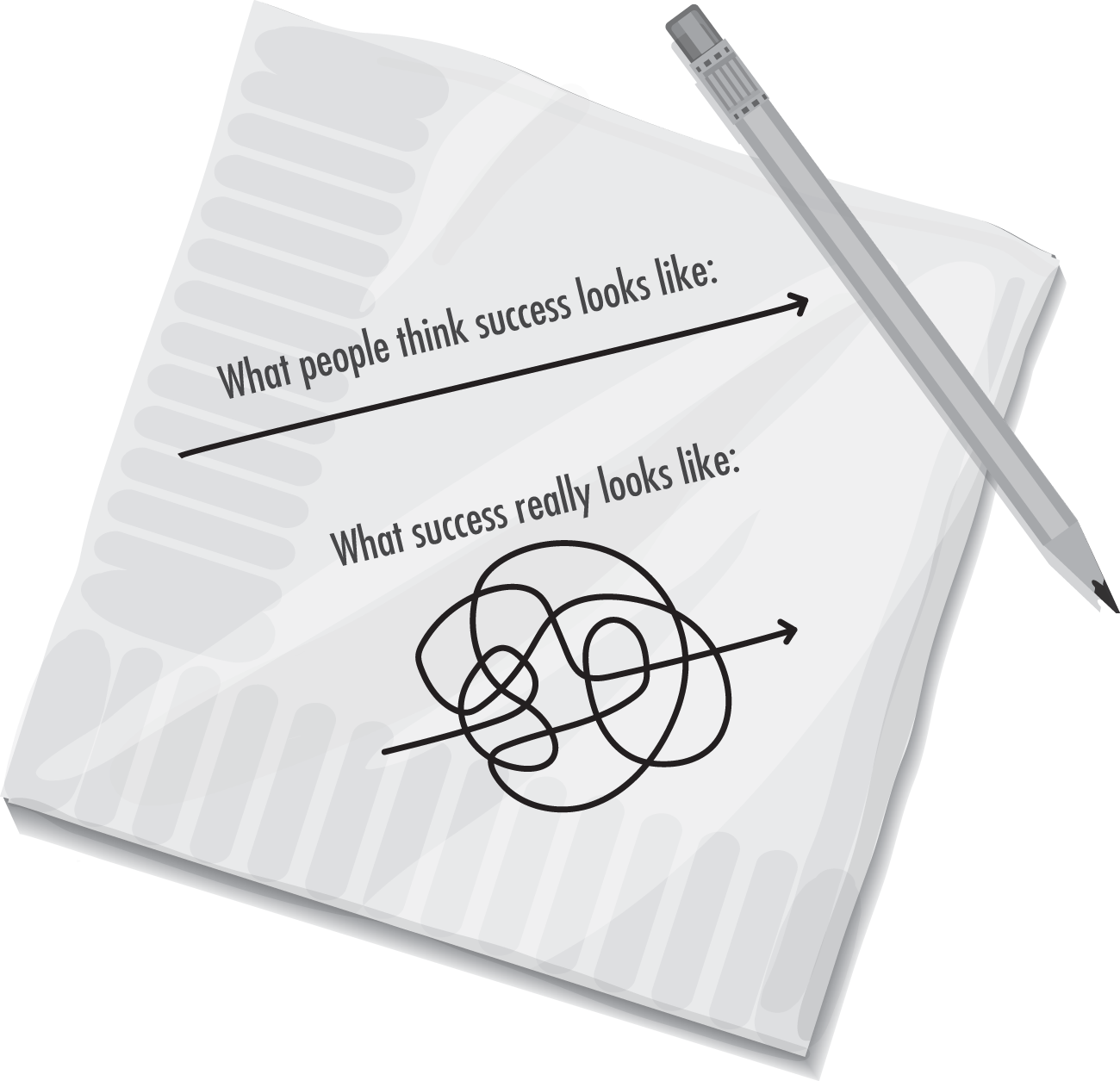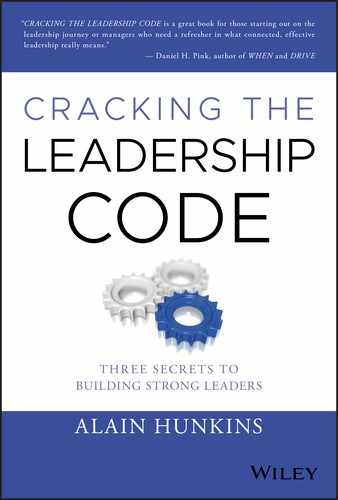EPILOGUE
Time to Leap
It's through a leader's actions—what he or she does and says on a daily basis—that the essence of great leadership becomes apparent.
—Travis Bradberry
When you embrace leadership as a journey of constant and never-ending improvement, sometimes the lessons come in the unlikeliest of places. Such as the dentist's chair.
First, a disclosure: the reason I keep going to the same dentist has nothing to do with my dentist. It's because Jackie, the hygienist, is amazing. Equal parts entertaining and educational, Jackie sees each tooth as a canvas and she's a da Vinci. Calling her skilled is an understatement. If you want to know anything about dental care, Jackie is your go-to.
One day, as I sat in the chair, I asked her, “With all of this new dental technology, with the sonic-powered and battery-powered and free-floating bristle head toothbrushes, what do you recommend? What's the best toothbrush out there?”
Jackie paused as she lifted her protective goggles to look me eye to eye. “The best toothbrush?” she grinned. “Oh, that's easy. It's the one that you'll use twice a day.”
Jackie's wisdom has application far beyond the bathroom sink. Any tool is only as good as its user's commitment to using it. And not just once—but consistently, over time.
THE MYTH OF LEADERSHIP DEVELOPMENT
It's easy to look at leaders you admire, those you deem “successful,” and put them up on a pedestal. As you bask in their radiant glow, you might imagine that their journey to greatness was a straight shot, with each victory building on the one before it. Every opportunity, every step, every advancement perfectly aligned with the one before. In comparison, how could imperfect you measure up?
The idea that effective leaders can plot their progression on a straight line is a myth. Progress is messy. Sometimes it's frustrating. Sometimes it's painful. Sometimes it feels like failure. You need to learn to accept the messiness and all the feelings associated with it. It's a surefire sign that you're growing.
Let go of the fallacy that everything will go according to plan. Nothing could be further from the truth. The road of progress only looks like a straight line when you look at it in reverse. It takes time, perspective, and synthesis to connect the dots in a linear fashion (see Figure E.1).
Each one of these squiggles represents the falls, faults, and failures along the way. That's what progress looks like when it's not airbrushed and Photoshopped. Exceptional leaders are exceptional learners—imperfect people who take each mistake along the way and figure out what they need to learn from it. Then, they do something to get back on course and keep moving.
For example, George Washington, the first president of the United States, will undeniably stay on the short list of fantastic leaders for centuries to come. Yet, he was anything but brilliant as a leader when he began. Early in his career, he failed miserably during the French-Indian War.
Leading a British troop, Washington ordered his company to erect a fort for defense: Fort Necessity. It was built in a most indefensible spot: a muddy creek bottom with higher ground around them on three sides. It was a terrible plan. On July 3, 1754, the 22-year-old Washington lost the battle for Fort Necessity. Disgraced, he resigned his post. In letters home, he shared the fear that his military career was over.

Figure E.1 The Road to Success Fallacy
Yet, as history has shown, Washington had a lot of improvement left in him. Not only did he grow into an exceptional leader but also he had the competence and foresight to lay the groundwork for what the presidency should look like for centuries to come. One of his defining traits as a general and later as president was his humility—a trait learned in part through his humbling experience in that muddy creek.
It's been said that “experience is the best teacher.” That's partially true. Experience is the best teacher if it's reflected on and learned from. That's why some people have 20 years of experience, and other people have one year of experience 20 times. If you can extract the lesson that each experience offers, you'll correct your course more quickly on the road to progress.
THE POWER OF SMALL CHANGES
If you want to be something different, you have to do something different. Try something. Notice what happens. If it works, then keep doing it. If it doesn't, notice it, and change your approach. For example:
- Try giving people your complete time and attention, like Matt the DM you met in the introduction.
- Try going on an extended listening tour, like Angela Ahrendts did when she became VP of retail stores at Apple (Chapter 4).
- Try asking for an understanding receipt rather than assuming everyone knows what you mean, as you saw in Chapter 8.
- Try making your implicit expectations explicit, like Lee, the sales executive you met in Chapter 8.
- Try using the “Platinum Rule,” like Kelly (the IT manager in Chapter 9) learned to do after his epic failure motivating his staff.
- Try starting a culture of appreciation by publicly celebrating a win with the team (like Laila, the project manager, did in Chapter 10).
- Try changing the default times for meetings to 25 or 50 minutes (a technique from Chapter 13).
The key is to try something. Anything. The magic comes from your effort.
Peter Sims, author of Little Bets: How Breakthrough Ideas Emerge from Small Discoveries, writes, “Most successful entrepreneurs . . . operate in this experimental way when trying new ideas. They think of learning the way most people think of failure.”1
Sims gives the example of Howard Schultz, the long-time CEO of Starbucks. When Schultz opened his first stores, he modeled them after the coffeehouses of Milan, Italy. Not everything went according to plan. Some of Schultz's missteps along the way included these:
- The original name of Schultz's cafes: Il Giornale. Difficult to pronounce.
- Baristas wearing bowties. Baristas were uncomfortable.
- Stores piping in opera music. Customers complained.
- No chairs. More customer complaints.
Schultz admits he made lots of mistakes, but he learned from them. This is precisely what John F. Kennedy meant when he said, “Leadership and learning are indispensable to each other.”2
YOU'RE AS READY AS YOU NEED TO BE
On your journey through these pages, you've gained numerous insights into leadership. You can now put leadership in its proper historical context. You've been witness to numerous examples of challenges and failures that have revealed a common theme:
You know that leadership is a relationship. People need to feel connected to you. If they're going to fully engage, they need to believe in your influence, not your authority. You can increase your influence through cultivating your empathy and your credibility.
You've discovered how much more there is to communication than just talking. You can now identify the biggest barriers to communicating well. You have tools to help you ratchet up your communication skill and raise your game.
You know that to thrive, you're going to need to lead collaboratively. You recognize that although you can't motivate anyone else, you can design the conditions in which they motivate themselves. You can use your understanding of human needs and the employee experience to lead a team of joyful, engaged, and high-performing people.
You have an abundance of tools to apply these principles. You've learned numerous pitfalls that will try and trip you up, despite your best efforts. You hold the keys to lead in your hand.
Don't just hold the keys: use them. Start unlocking doors. Use these skills. See what happens. Some of the doors you try will open easily. Others will remain shut. If they stay closed, find a different approach and try again.
You can choose any number of places to start. But before you do, here's a little secret that leaders know: you'll never be 100% ready.
When it comes to preparation, there's always something else you can do. When it comes to gathering information, there's always more you can get. When it comes to getting input from others, there's always someone else to talk to.
Believe in yourself. Walking the path of leadership takes courage. Stepping out without being ready is scary, yet necessary.
Years ago, I participated in a daylong outdoor adventure high-ropes course. The course included several elements that involved using mountain climbing harnesses and ropes. These components served as physical metaphors for the obstacles of leadership.
When I arrived at the final element, I could see they had saved the best for last. This element was called “The Leap of Faith.” This element involved a wooden pole (picture a telephone pole), about 50 feet high, with metal rungs like a ladder on the side. On the top of the pole was a small platform, which was the size of a pizza box. The climber (wearing a full body harness) climbs to the top, stands on the platform, and then leaps out to grab a trapeze bar that is only reachable if you fully extend. It's a literal “leap of faith.”
I was with a group of five other climbers. I chose to go last, and as each person went in front of me, I could feel my pulse quicken. Finally, it was my turn.
The metal rungs felt cold in my hands. As I heaved myself up, the breeze wafted across my face and as I climbed higher and higher I was able to see over the tops of the trees and see the hills in the distance. My heart rate climbed along with my elevation. By the time I got near the top, it felt as though my heart would explode out of my chest. My adrenaline was surging.
I stepped onto the platform, trying to gain my balance as the wind swirled around me. My heart was pounding, my legs shook, and my vision blurred. The trapeze bar was out in front of me.
I just stood there. Waiting. When was the right time to go? A full minute seemed to pass as I waited for a sign to make my move. Would the clouds part and a beam of sunlight pour down? Or would I hear Alec Guinness's voice in my head saying, “Use the force. Trust your feelings”?
I kept waiting. But no sign ever came.
Then, a chill ran down my spine and the hairs on the back of my neck stood on end in a flash of insight. Suddenly, I got the lesson.
In that moment, I realized that there would be no “right time.” No perfect convergence. No preordained moment. This moment is as good as any. As a leader, sometimes you just go. You choose: now is the time. You don't need permission.
So I leapt. My fingertips brushed off the trapeze bar as I missed it and fell. My team kept me safe in my climbing harness.
When I got down to the bottom, I asked if I could go again. Having done it once, I knew what adjustments I needed to make to succeed this next time. The second time out, I was ready. I leapt and caught hold of the bar.
Decide. Leap. Go. Watch. Reflect. Learn. Apply. Go again.
After all, if not now, then when?
If not you, then who?
We need a new type of leader, one who can excel at navigating this exciting new world.
Go be one of them.
